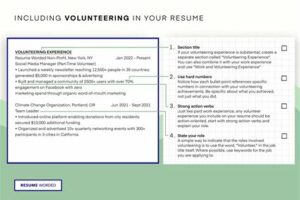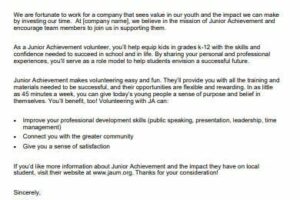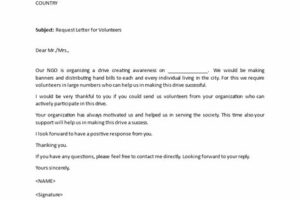Table of Contents
Learn how to effectively format volunteer work on your resume with our step-by-step guide. Discover the best placement, formatting styles, and terminology to showcase your volunteer experience in a professional manner. Impress potential employers and highlight your commitment to giving back to the community.
Highlighting your volunteer work on your resume can greatly enhance your chances of standing out to potential employers. Not only does it demonstrate your commitment to giving back to the community, but it also showcases valuable skills and experiences that can be transferable to the workplace. However, knowing how to format volunteer work effectively can be a bit tricky. In this guide, we will walk you through the best practices for incorporating your volunteer experience into your resume, ensuring that it captures the attention of hiring managers and boosts your professional profile.
Introduction
Volunteer work can be a valuable addition to your resume, showcasing your dedication, skills, and commitment to making a positive impact in your community. Whether you’ve volunteered for a local charity, non-profit organization, or community event, it’s important to effectively format this experience on your resume to highlight its relevance and value to potential employers. In this article, we will discuss how to format your volunteer work on a resume to maximize its impact.
Choose the Right Resume Format
When incorporating volunteer work into your resume, it’s essential to choose the right resume format that best highlights your experiences and skills. The two most commonly used formats are the chronological and functional resumes. The chronological format is ideal if your volunteer work aligns with your career goals and you have a continuous work history. On the other hand, the functional format is suitable if you have limited work experience in the field or if your volunteer work is more relevant to the position you’re applying for.
Include a Volunteer Work Section
To emphasize your volunteer work, create a dedicated section on your resume titled Volunteer Experience or Community Involvement. This section should come after your professional experience, education, and any other relevant sections. By clearly labeling your volunteer work, you make it easier for hiring managers to identify and appreciate your commitment to giving back.
Provide Detailed Descriptions
Underneath each volunteer position, provide a concise but detailed description of your responsibilities and achievements. Use action verbs and quantify your impact whenever possible. For example, instead of saying volunteered at a local food bank, say coordinated and led a team of volunteers, serving over 500 meals to those in need. These specific details help employers understand the scope and value of your contribution.
Showcase Transferable Skills
Highlight the skills you gained through your volunteer work that are applicable to the job you’re applying for. Whether it’s leadership, teamwork, communication, or problem-solving, make sure to mention these transferable skills in your descriptions. This demonstrates your ability to adapt and apply your experiences from volunteer work to a professional setting.
Include Relevant Achievements
If you received any awards, recognition, or achieved significant milestones during your volunteer experience, be sure to include them on your resume. These achievements help distinguish you from other candidates and showcase your dedication and impact within the organization or community.
Use the Right Keywords
Incorporate relevant keywords throughout your resume to ensure it aligns with the requirements of the desired position. Analyze job postings and industry-specific terms to identify keywords that reflect the skills and experiences needed. This will increase the chances of your resume passing through applicant tracking systems (ATS) and catching the attention of hiring managers.
Quantify Your Impact
Whenever possible, quantify the impact of your volunteer work by including statistics or numbers. For example, mention the number of hours you dedicated, the amount of funds raised, or the number of people you helped. Quantifying your impact adds credibility to your accomplishments and gives employers a clearer picture of what you can bring to their organization.
Order of Importance
If you have extensive volunteer experience, prioritize the most relevant positions or those that align closely with the job you’re applying for. Place them at the top of your volunteer work section to draw immediate attention. However, if you have limited volunteer experience, it’s advisable to include all positions to demonstrate your commitment to community involvement.
Keep It Concise
While it’s important to provide enough information about your volunteer work, keep in mind that your resume should be concise and easy to read. Aim for a one-page resume unless you have extensive experience. Use bullet points and avoid lengthy paragraphs. Focus on the most impactful aspects of your volunteer work and tailor them to match the requirements of the desired position.
Conclusion
By effectively formatting your volunteer work on your resume, you can showcase your commitment to making a difference while highlighting valuable skills and experiences. Remember to choose the right resume format, provide detailed descriptions, quantify your impact, and emphasize transferable skills. With a well-structured resume, you’ll increase your chances of impressing potential employers and securing the job opportunities you desire.
Introduction to Formatting Volunteer Work on a Resume
Formatting volunteer work on a resume is crucial to effectively showcase your achievements and skills in a professional manner. Properly structuring this section can highlight your commitment to social causes and engage potential employers. In this article, we will provide you with invaluable tips on how to format your volunteer work on a resume.
Organizing Your Volunteer Experience
When formatting your volunteer work section, consider listing it alongside your professional experience to ensure a comprehensive overview of your skills. Use a separate heading titled Volunteer Work or Community Involvement and detail the name of the organization, your role, dates, and any exceptional accomplishments or relevant responsibilities.
Highlighting Transferable Skills
While presenting your volunteer experience, concisely highlight the transferable skills you have acquired. These skills may include leadership, teamwork, communication, problem-solving, and adaptability. Emphasize how these abilities relate to the desired position and how they would benefit the prospective employer.
Showcasing Impact and Achievements
To make your volunteer work stand out, focus on quantifiable achievements. Describe specific projects or initiatives you undertook and highlight the positive impact they had on the community or organization. Use metrics such as the number of people served, funds raised, or successful collaborations to demonstrate your effectiveness.
Incorporating Relevant Training and Certifications
If you have received any training or certifications during your volunteer work, include them on your resume. For instance, if you completed a course on leadership development or earned a certification in a relevant field, make it visible within the volunteer section to further enhance your qualifications.
Utilizing Volunteer Work in the Professional Experience Section
For individuals with extensive volunteer experience or limited professional experience, consider integrating your volunteer work into the professional experience section. This approach prevents potential employers from overlooking your valuable skills and highlights your commitment to community engagement.
Ordering and Formatting Bulleted Statements
When presenting your accomplishments and responsibilities, format them using concise bullet points. Begin each bullet point with action verbs to effectively communicate your skills and achievements. Ensure the statements are clear, specific, and relevant to the position you are applying for.
Tailoring Your Volunteer Work for Each Application
Lastly, customize your volunteer work section for each application to align it with the needs and requirements of the specific role. By tailoring your descriptions and focusing on the most relevant experiences, you can effectively demonstrate how your volunteer work is applicable and beneficial to the organization you are applying to.
When it comes to including volunteer work on a resume, it is important to format it in a way that highlights your skills and experiences effectively. By following a professional voice and tone, you can present your volunteer work in a clear and concise manner, demonstrating its value to potential employers.
Here are some tips on how to format volunteer work on your resume:
- Include a dedicated section: Create a separate section for your volunteer experience, placing it after your professional work experience. This will ensure that it receives the attention it deserves and stands out to hiring managers.
- Provide a clear heading: Use a bold and descriptive heading for your volunteer work section, such as Volunteer Experience or Community Involvement. This will help to clearly differentiate it from your paid work experience.
- List your volunteer positions: Begin by listing the name of the organization or cause you volunteered for, followed by your position or role. Use bullet points to describe your responsibilities and accomplishments within each role. Focus on the skills and experiences that are relevant to the position you are applying for.
- Show impact and results: Whenever possible, quantify your achievements to demonstrate the impact you made during your volunteer work. For example, mention the number of people you helped, funds you raised, or projects you successfully completed. This will help employers understand the value you can bring to their organization.
- Highlight transferable skills: Volunteer work often allows individuals to develop valuable skills that can be applicable in a professional setting. Be sure to highlight these transferable skills, such as leadership, communication, teamwork, project management, and problem-solving abilities.
- Include relevant certifications or training: If you have obtained any certifications or completed training programs during your volunteer work, make sure to include them. This will demonstrate your commitment and dedication to personal and professional growth.
- Use reverse chronological order: Present your volunteer experiences in reverse chronological order, starting with the most recent position. This allows employers to see your most recent involvement and demonstrates ongoing commitment to community engagement.
- Keep it concise: While it is important to provide enough detail about your volunteer work, be mindful of keeping it concise. Focus on the most relevant and impactful experiences, using bullet points to highlight key achievements and responsibilities.
By following these formatting tips, you can effectively showcase your volunteer work on your resume, presenting yourself as a well-rounded candidate with valuable skills and experiences acquired through your community involvement.
Thank you for visiting our blog and taking the time to learn about how to format volunteer work on your resume. In today’s competitive job market, it is essential to showcase all relevant experience, including volunteer work, to stand out from other applicants. By following the guidelines outlined in this article, you can effectively highlight your volunteer experience, demonstrating your commitment to making a difference in your community.
When formatting your resume, it is important to create a separate section specifically for volunteer work. This allows hiring managers to easily identify and recognize your non-profit contributions. Start by listing the organization or cause that you volunteered for, followed by the position or role you held. Use action verbs and specific examples to describe your responsibilities and accomplishments in each role. For instance, instead of simply stating that you volunteered at a local food bank, you could mention that you led a team of volunteers in organizing and distributing food to over 500 families per week. This level of detail provides a clearer picture of your skills and the impact you made.
In addition to highlighting your responsibilities, it is vital to emphasize the transferable skills gained through volunteer work. These skills can be valuable in various professional settings. For example, if you volunteered as a mentor for underprivileged youth, you likely developed strong communication, leadership, and problem-solving skills. These skills are highly sought after by employers and can set you apart from other candidates. Be sure to include specific examples of how you applied these skills during your volunteer experience.
As you update your resume, remember to tailor it to the specific job you are applying for. Highlight the volunteer experiences that are most relevant to the position and align with the company’s values and mission. Consider using keywords and phrases from the job description to demonstrate your fit for the role. Additionally, if you have limited professional experience, volunteer work can help fill any gaps in your resume and demonstrate your commitment and dedication to personal growth.
Overall, incorporating volunteer work into your resume can showcase not only your compassion and commitment to giving back but also your valuable skills and experiences. It is essential to present your volunteer work in a professional manner, using a clear and organized format. By following the guidelines provided in this article, you can effectively highlight your volunteer work, demonstrating your unique qualifications and making a positive impression on potential employers.
Thank you again for visiting our blog. We hope that the information provided here will help you in successfully formatting your volunteer work on your resume. Best of luck in your job search!
.
1. How should I format volunteer work on my resume?
When formatting volunteer work on your resume, follow these guidelines:
- Include a separate section for volunteer experience.
- Use a clear heading such as Volunteer Experience or Community Involvement.
- List the name of the organization or cause you volunteered for, along with the dates of your involvement.
- Provide a brief description of your responsibilities and accomplishments during your volunteer work.
- Highlight any relevant skills or experiences gained through volunteering.
- If applicable, include any leadership positions or special projects you were involved in.
2. Should I include all my volunteer work on my resume?
While it’s not necessary to include every single volunteer experience on your resume, try to showcase the most relevant and impactful ones. Focus on volunteer work that aligns with the job you’re applying for or demonstrates transferable skills. Select experiences that highlight your dedication, teamwork, leadership, or any other qualities sought by the employer.
3. How do I demonstrate the value of my volunteer work to employers?
To effectively demonstrate the value of your volunteer work to employers:
- Quantify your impact: Highlight specific achievements or outcomes resulting from your volunteer work, such as funds raised, people served, or projects completed.
- Emphasize transferable skills: Describe the skills you developed or utilized during your volunteer work that are relevant to the job you’re seeking, such as communication, organization, problem-solving, or teamwork.
- Show dedication and commitment: Highlight long-term or ongoing volunteer positions to showcase your commitment and reliability.
- Share positive feedback or testimonials: If you received any commendations or positive feedback from supervisors or beneficiaries, consider including them to reinforce the value of your volunteer work.
4. Can volunteer work be listed as professional experience?
Yes, volunteer work can be listed as professional experience, especially if it is directly related to the job you are applying for or if it provided you with valuable skills and experiences. When listing volunteer work as professional experience, follow the same formatting guidelines as you would for paid positions, including organization name, dates, and a concise description of your responsibilities and accomplishments.
5. Is it necessary to mention unpaid volunteer work on my resume?
In general, it is not necessary to specifically mention that your volunteer work was unpaid on your resume. The focus should be on the skills, experiences, and contributions gained through your volunteer work rather than the compensation. However, if the fact that the work was unpaid is relevant to the position or showcases your dedication, you may choose to mention it briefly in your description.






